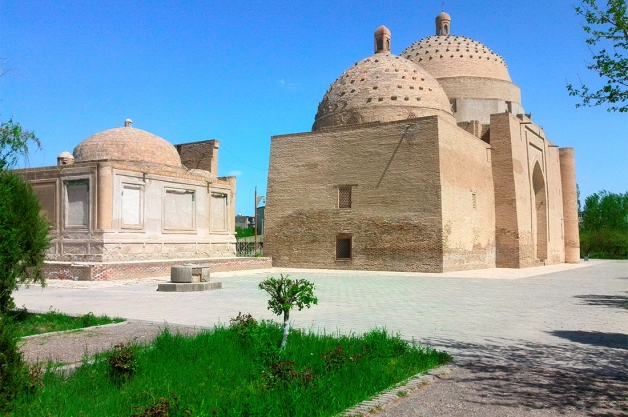Saif ed-Din Bokharzi and Bayan-Quli Khan Mausoleums in the Bukhara Suburbs
The Sufi monastery in the Fathabad settlement in Bukhara Region emerged during one of the most ambiguous historical periods for the Muslim world. The 13th century was marked in Central Asia by bloody massacres and the decline of spiritual, economic, social, and cultural life. Such situlation is associated with the devastating Mongol invasion. The survivors of the local population could not and did not want to get along with the Tatar-Mongolian order, which was anti-religious and barbaric for the people of Central Asia, and local rebellions were breaking out everywhere.
For the first time since the establishment of Islam in the region, it started to be dominated by adherents of a different faith, and it even lost the status of the state religion. This situation revived the cultic perception of the mazars (tombs) of the saints.
Sufism (tasawwuf) emerged a century after the spread of Islam. Under the oppression of the Mongols, people turned to the Sufis who professed a philosophy of the mystical and irrational cognition of God. Alims, the canonical theorists and practitioners of Islam, lost their authority. The Sufi orders of "tariqa" were formed meaning the spiritual path that only the chosen messengers of God, the "auliya," could follow. They were destined to do educational activities for the benefit of the people and to be always ready to support people in their hardships. Thus, the community of the order consisted of common people and dedicated Sufi teachers. The sheikhs who gained popularity during their lifetime became cult saints after their death, to whose graves the pilgrims started going for worship.
In this way, political and social events influenced the worldview of Muslims: inside the confessional group, the tombs of saints, without being formally proclaimed, became the new dominant religious elements.
In the 13th century, the Sufi khanaka was founded by the Kubrawi sheikh and poet Abū al-Maʿālī Sayf al-Dīn Saʿīd b. al-Muṭahhar b. Saʿīd Bākharzī (shortened, Saif ed-Din Bokharzi) in the suburbs of Bukhara. The Kubrawi Brotherhood, which existed until the 18th century, was founded in Khorezm by Najm al-Din Kubra, a teacher of Bokharzi. Al-Kubra died in 1221 as a result of the Mongol attack, though he managed to appoint Bokharzi as his vicegerent in Bukhara. Kubrawi was a Sunni school of ascetic mysticism that popularized the views of al-Kubra. The school quickly gained followers and spread as far as the Chinese borders.
After he died in 1261, the theologist was buried in the khanak of Fathabad. The mausoleums of Bokharzi and his companions formed a singular ideological center. The whole quarter here was given as dormitories (khanaka) for the monks (dervishes). They were forbidden to engage in profitable activities and were required to be prepared for a life of poverty and to live only on donations. Renunciation of secular values, modest attire (the word "Sufism" itself means "attire in a woolen hair shirt"), ration, and selfless work for attaining high spiritual perfection are characteristics of this order. The frugality of the service correlates Sufism with the mystical movements of Judaism and Christianity, Hinduism and Buddhism.
The requirements of the order were impeccable knowledge of the postulates of the doctrine, comprehension of which took more than one year, as well as the performance of Islamic spiritual practices: fasting, contemplation and the vow of silence, silent and loud zikr, a meditative recitation of the prayer glorifying God after the namaz, and observance of ritual purity. In Kubrawi tariq, the authority of the main sheikh was inherited. Thus, all descendants of Boharzi succeeded to the title of the sheikh and headed the Fathabad community.
Ordinary people from the community of the Kubrawi order could comprehend the depths of the teachings, but at the same time adhere to the ordinary way of life. Obligations were related to the unswerving observance of moral standards, the payment of membership dues, and the material support of the brotherhood. The flow of those wishing to join continued unabated: in such difficult times, only unity and a sense of belonging to the true doctrine, as opposed to materialism, could give peace of mind to the tormented people. In addition, members of the Order received more weight and prestige in society, unofficially.
The mausoleum of Saif ed-Din Bokharzi, a Sufi who received the title of "Sheikh al-alam" ("Sheikh of Peace") was completed in 1358 with the construction of the tomb of Bayan-Quli Khan.
At the end of the 14th century, a global reconstruction of the Saif ed-Din Bokharzi Mausoleum was carried out, and it is the view we see today. The mausoleum attracts the eye with its sweeping construction, exquisite lightness, and clarity of geometric lines. It consists of two halls, where the tomb and the adjoining prayer room called ziyarat-hona are located, covered from above by two domes. The absence of decorative elements on the facade reinforces the sense of purity and weightlessness of the space.
Saif ed-Din Bokharzi and Bayan-Quli Khan Mausoleums form a magnificent architectural ensemble, preserving the religious and cultural significance and inexhaustible faith through the centuries.









